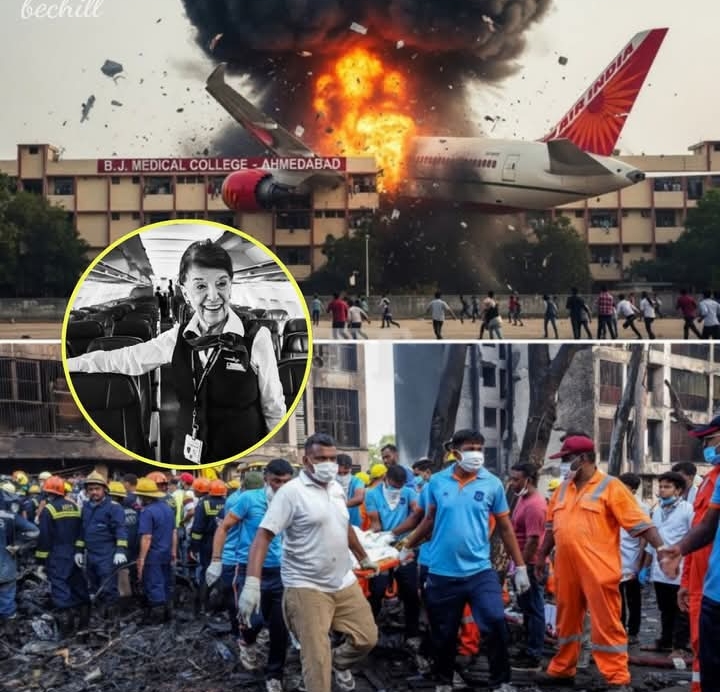Finally, the Full Story Behind the Tragic Crash of Air India Flight 171 Has Been Revealed — And It’s More Heartbreaking Than Anyone Imagined
For years, the mysterious crash of Air India Flight 171 has been shrouded in speculation, unanswered questions, and lingering grief for the families of the 232 people who lost their lives. Now, after a painstaking investigation and countless hours of interviews, the final report has been released — and the cause is as shocking as it is tragic: human error.
On the morning of the disaster, Air India Flight 171, a Boeing 777 bound for Milan from Mumbai, was scheduled for a routine long-haul flight. The weather was clear, visibility was excellent, and the aircraft had passed all pre-flight checks. Passengers settled in, chatting quietly, scrolling through their phones, or reading newspapers as the flight crew prepared for takeoff.
But what no one knew at the time was that a chain of small, seemingly insignificant oversights would converge into a catastrophic sequence of events — and at the center of it all was an 81-year-old veteran flight attendant, beloved by colleagues but ultimately at the heart of the fatal error.
According to the newly released report, the flight attendant, identified only as “Ms. K,” had been serving with Air India for more than five decades. Known for her kindness and professionalism, she had been a fixture of the airline’s image for generations of passengers. On Flight 171, she was assigned to the front galley, overseeing safety checks before departure.
It was during this phase that the first critical mistake occurred. Investigators believe Ms. K inadvertently triggered a cockpit alert while conducting a door mechanism inspection. The captain, assuming it was a minor sensor malfunction — something not uncommon in older aircraft — reset the system without further investigation. This reset, as the report details, temporarily disabled a key hydraulic pressure monitoring system.

As the aircraft climbed to cruising altitude, another complication arose. The same system, now unable to detect a gradual loss of hydraulic pressure, failed to send warnings to the cockpit. Without hydraulic support, critical control surfaces began to respond sluggishly. In normal circumstances, backup systems would have been activated — but the earlier reset prevented them from fully engaging.
The turning point came 90 minutes into the flight. A mild vibration in the left wing prompted the first officer to run diagnostic checks. By the time the crew realized the hydraulics were compromised, the aircraft’s handling had deteriorated sharply. Attempts to stabilize it were hampered by the reduced control, and the situation quickly escalated into an unrecoverable descent.
Witnesses on the ground described the horrifying sight of the massive jet banking sharply before plunging toward a remote hillside outside Milan. The impact was instantaneous and devastating, leaving no survivors.
In the days following the crash, speculation ran rampant — from mechanical failure to sabotage. The airline maintained that it would “cooperate fully” with investigators, but insiders admit there was enormous pressure to protect its reputation. The detail about Ms. K’s role remained buried until this final report was released.
The revelation has sent shockwaves through both the aviation industry and the public. While the report does not accuse Ms. K of negligence, it points to a “critical procedural lapse” compounded by outdated safety systems and insufficient training for senior crew members. Experts stress that the tragedy was the result of a “perfect storm” of human error and systemic oversight, not a single individual’s fault.
Aviation analyst Dr. Rohan Malhotra explained, “In modern aviation, accidents are almost never caused by one mistake alone. They’re the result of multiple breakdowns in procedure, design, and decision-making. Here, a momentary action by a veteran crew member interacted with a system vulnerability — and tragically, the safeguards in place were not enough.”
Families of the victims are grappling with the new details. Some have expressed anger that the truth was withheld for so long. “We deserved to know,” said one man who lost his wife and two children on the flight. “They kept telling us they didn’t know the cause. But they knew enough to point to the real problem years ago.”




